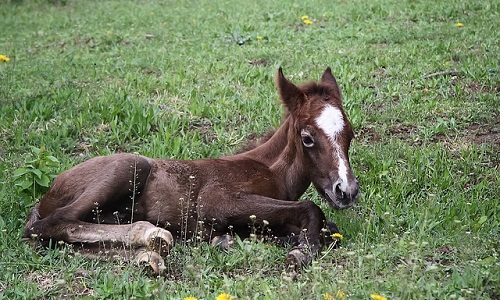Horse breeding sounds simple, but can actually be quite complicated. You start by selecting a mare, or female horse, and a stallion, a male horse, with complementary qualities that will yield a young foal who will be capable of performing whatever tasks you have in mind for him. Whether your purposes are farm work, showmanship, or racing after you have allowed the stallion to cover the mare you will be left waiting to see if a pregnancy has ensued. The early signs of horse pregnancy are not much different than those of other mammals, specifically humans, except that she cannot tell you what is happening. So, you will need to keep your eyes peeled for these six signs of pregnancy in a horse.
- Refusal to Conceive: Though not an exact science, one of the easiest ways that might indicate your mare is in foal is to take her back to a stallion approximately two weeks after the covering. If she raises her tail and presents her hindquarters as she would in heat, she is likely not pregnant. Though refusal to be sired is not a guarantee that she is in foal, most pregnant mares will refuse the advances of a stallion if she has already conceived.
- No Signs of Heat: Similar to the above, if your mare displays the signs of being in heat she is most likely not pregnant. Signs your mare is in heat include carrying her tail up and squealing when in contact with geldings or stallions. However, this once again does not guarantee she is in foal. Mares will only be in heat during the breeding seasons of spring and summer. In addition, she may experience what is known as a silent heat during which she ovulates as normal but will not stand for a stallion to cover her.
- Visible Stomach: Much like humans, the most obvious sign of a pregnant mare is a swollen abdomen. While this is a good indication of pregnancy, some horses may not develop an overly large belly or it may not be noticeable until well into her 11-month gestation.
- Limited Movement: Though likely an old myth, and definitely not a reliable way to confirm a mare’s pregnancy, is the notion that a mare will only shake her head and neck when carrying rather than her body to protect the unborn foal.
- Rectal Examination: A veterinarian can detect a pregnancy by performing a rectal examination. This procedure can take place as soon as three weeks after the mare’s covering and will consist of the vet inserting his hand into her rectum in order to palpate the uterus, assess its size and shape, while also feeling for any swelling of the ovaries.
- Ultrasound: The only true method to be certain of your mare’s successful covering is to have a veterinarian perform an ultrasound. This can be done as early as 16 days into the pregnancy which will detect a heartbeat, though it is more often done around 55 to 70 days in an effort to determine the foal’s sex.
 If your mare is, in fact pregnant, you will need to work to provide appropriate care for her during the gestation. First, you will need to ensure she is receiving proper nutrition to support the pregnancy. If she was in good body condition prior to the pregnancy, you should not need to worry about her calorie intake until about month eight or nine of the gestation. At that point, the foal will start to gain weight rapidly requiring your pregnant mare to consume at least 20% more calories as well as additional protein, calcium, and phosphorus.
If your mare is, in fact pregnant, you will need to work to provide appropriate care for her during the gestation. First, you will need to ensure she is receiving proper nutrition to support the pregnancy. If she was in good body condition prior to the pregnancy, you should not need to worry about her calorie intake until about month eight or nine of the gestation. At that point, the foal will start to gain weight rapidly requiring your pregnant mare to consume at least 20% more calories as well as additional protein, calcium, and phosphorus.
Secondly, you should review the mare’s vaccinations and ensure she is keeping up with her routine vaccination and booster schedule. In addition, your horse should be vaccinated against Equine Herpes Virus at the start of the fifth, seventh, and ninth months of mare gestation to prevent miscarriage due to infection.
Finally, you will need to be adequately prepared for the foaling, or birth, when it happens. Prior to the foal’s arrival, make sure that you have appropriate shelter and fencing surrounding the horse so as you don’t expose the new foal to any dangers. The foaling stall should also be bedded with plenty of straw. When ready, the foal will present itself front feet first, with the nose appearing between the two feet. The delivery should last only about 30 minutes. Afterward, the foal should be standing within two hours and nursing within three. If this is not the case, your veterinarian should be contacted immediately to provide further care to the foal.
Sources:
“What to Expect When Your Mare Is Expecting.” The Spruce Pets, Accessed 19 Oct. 2018. www.thesprucepets.com/pregnancy-in-horses-1885935.
“How Can I Tell If a Mare Is Pregnant? – The Horse.” The Horse, 22 June 2018, Accessed 19 Oct. 2018. www.thehorse.com/149581/how-can-i-tell-if-a-mare-is-pregnant/.
Smith, Donna. “Signs and Stages of Pregnancy in a Mare.” PetHelpful, 26 Dec. 2016, Accessed 19 Oct. 2018. www.pethelpful.com/horses/Signs-and-Stages-of-Pregnancy-in-the-Mare.
“Signs of Imminent Foaling in Mares.” Kentucky Equine Research, 22 Jan. 2018, Accessed 19 Oct. 2018. www.ker.com/equinews/signs-imminent-foaling-mares/.




